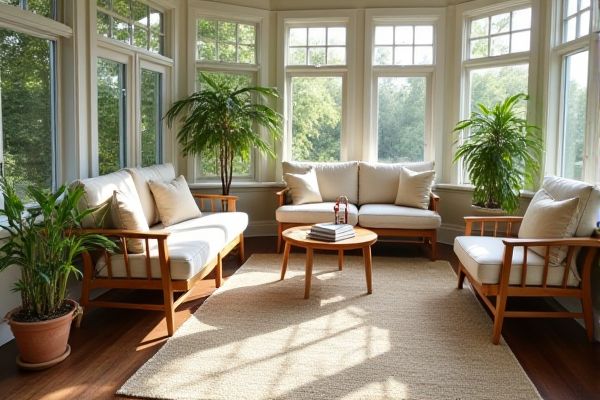
Natural fiber rugs, such as jute or sisal, offer eco-friendly durability and a warm, organic texture that enhances your sunroom's natural light and airy feel, while synthetic fiber rugs provide greater stain resistance and colorfastness ideal for high-traffic areas or spaces exposed to moisture. Explore the rest of this article to determine which rug type best suits your sunroom's style and functionality.
Table of Comparison
| Feature | Natural Fiber Rug | Synthetic Fiber Rug |
|---|---|---|
| Material | Wool, jute, sisal, coir | Nylon, polyester, polypropylene |
| Durability | Moderate; prone to moisture damage | High; water and stain resistant |
| Maintenance | Requires gentle cleaning; avoid excess moisture | Easy to clean; resists staining and fading |
| Comfort | Soft, natural texture | Varies; often less soft than natural fibers |
| Sunroom Suitability | Less ideal; sensitive to humidity and sunlight | Ideal; withstands sun exposure and humidity |
| Eco-Friendliness | Biodegradable, renewable | Non-biodegradable, petroleum-based |
| Price | Generally higher | Generally lower |
Introduction to Sunroom Rug Choices
Sunroom rug choices often come down to natural fiber rugs like jute or sisal and synthetic fiber options such as polypropylene or nylon. Natural fibers offer eco-friendly, breathable textures ideal for bright, airy sunrooms but may require more maintenance due to sensitivity to moisture. Synthetic fiber rugs provide durability, stain resistance, and easy cleaning, making them practical for high-traffic sunroom areas where spills and dirt are concerns.
Defining Natural Fiber Rugs
Natural fiber rugs consist of materials such as jute, sisal, coir, and wool, renowned for their eco-friendliness and biodegradability. These rugs offer excellent breathability and a textured, organic aesthetic ideal for sunrooms, where natural light enhances their earthy tones. Unlike synthetic fiber rugs, natural fibers provide superior moisture absorption but require careful cleaning to maintain durability in humid environments.
Understanding Synthetic Fiber Rugs
Synthetic fiber rugs in sunrooms offer enhanced durability and resistance to moisture, making them ideal for spaces exposed to sunlight and humidity. These rugs, often made from polypropylene, nylon, or polyester, resist stains and fading better than natural fibers like wool or jute. Choosing a synthetic fiber rug can prolong your sunroom's aesthetic appeal while simplifying maintenance and cleaning tasks.
Aesthetic Appeal: Natural vs. Synthetic in Sunrooms
Natural fiber rugs, such as jute or sisal, offer a warm, organic aesthetic that complements the bright, airy atmosphere of sunrooms, enhancing the connection to nature. Synthetic fiber rugs provide a wider range of vibrant colors and patterns, maintaining their appearance despite sunlight exposure and resisting fading over time. Your choice depends on whether you prioritize the timeless, earthy texture of natural fibers or the durable, customizable look of synthetic options for your sunroom's decor.
Durability and Longevity Comparison
Natural fiber rugs such as jute and sisal offer moderate durability but tend to degrade faster in sunroom environments due to moisture and UV exposure. Synthetic fiber rugs made from polypropylene or nylon provide superior resistance to fading, staining, and wear, making them ideal for sunrooms with high sunlight and humidity. Over time, synthetic rugs typically maintain their appearance and structural integrity longer, ensuring greater longevity in sun-exposed spaces.
Comfort and Texture Differences
Natural fiber rugs, such as jute, sisal, or wool, offer a softer and more breathable texture that enhances comfort in sunrooms by maintaining a cool and fresh environment. Synthetic fiber rugs like nylon or polyester tend to be less breathable and may feel rougher, but they provide greater resistance to moisture and UV damage, making them durable choices for sun-exposed areas. The tactile warmth and organic feel of natural fibers create a cozy ambiance, while synthetic rugs prioritize practicality with stain resistance and easier maintenance.
Maintenance and Cleaning Requirements
Natural fiber rugs in sunrooms require gentle vacuuming and spot cleaning with mild detergents to prevent damage and preserve their organic texture, while avoiding excess moisture that can lead to mold. Synthetic fiber rugs offer greater durability for sunroom environments, allowing for more frequent vacuuming and resistance to stains, making them easier to maintain with standard cleaning solutions. Choosing between these rugs depends on balancing the desire for eco-friendly materials with the need for practical, low-maintenance upkeep in bright, sun-exposed spaces.
Sustainability and Environmental Impact
Natural fiber rugs such as jute, sisal, and wool offer superior sustainability due to their biodegradability and renewable sourcing, making them an eco-friendly choice for sunrooms. Synthetic fiber rugs, often made from petroleum-based materials like nylon or polypropylene, contribute to environmental pollution during production and are not biodegradable, resulting in long-term waste issues. Choosing natural fiber rugs reduces carbon footprint and supports sustainable practices by minimizing chemical use and promoting soil health through sustainable agriculture.
Cost Considerations for Sunroom Rugs
Natural fiber rugs like jute or sisal typically cost more upfront but offer eco-friendly benefits and a unique texture ideal for sunrooms. Synthetic fiber rugs such as polypropylene are usually more affordable, stain-resistant, and easier to maintain in high-traffic or sun-exposed areas. Your choice should balance budget constraints with durability and aesthetic preferences for the sunroom environment.
Best Rug Choice for Your Sunroom
Natural fiber rugs, such as jute or sisal, offer breathable, eco-friendly options that complement sunrooms by withstanding sunlight and moderate moisture while adding organic texture. Synthetic fiber rugs like polypropylene excel in durability, stain resistance, and color retention, making them ideal for high-traffic or humidity-prone sunrooms. Your best rug choice depends on balancing natural aesthetic preferences with maintenance needs and environmental conditions in your sunroom.
 homyna.com
homyna.com